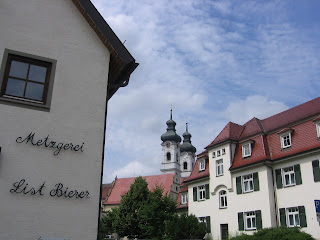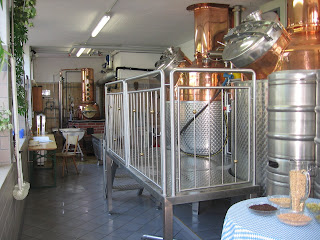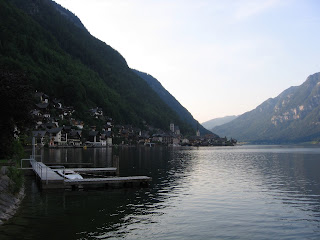 BANG…BANG…BANG! Hammer. Hammer. Saw. Saw. Ah. The head pounding sounds of an apartment tear-out and reconstruction that began at 7:00am on a Monday morning. We are surprisingly awakened and told that the apartment above us is being renovated over the next three weeks….only now we are into week six and the construction continues. I have a complete freak out over the noise, throw some camping gear in Michelle’s Twingo, and we hit the road, planning to be gone for three days. Three days comes and goes and suddenly becomes four, then five, six and upwards adding up to fourteen days total. Michelle only packed one pair of pants while I brought one pair of shorts. We were clothing minimalists, only having to buy underwear and a few toiletry items along the way. Our fourteen day journey covers two countries; Southern Germany and two cities in the Czech Republic. Our mission? To explore the beer scene in these two countries and experience the local culture.
BANG…BANG…BANG! Hammer. Hammer. Saw. Saw. Ah. The head pounding sounds of an apartment tear-out and reconstruction that began at 7:00am on a Monday morning. We are surprisingly awakened and told that the apartment above us is being renovated over the next three weeks….only now we are into week six and the construction continues. I have a complete freak out over the noise, throw some camping gear in Michelle’s Twingo, and we hit the road, planning to be gone for three days. Three days comes and goes and suddenly becomes four, then five, six and upwards adding up to fourteen days total. Michelle only packed one pair of pants while I brought one pair of shorts. We were clothing minimalists, only having to buy underwear and a few toiletry items along the way. Our fourteen day journey covers two countries; Southern Germany and two cities in the Czech Republic. Our mission? To explore the beer scene in these two countries and experience the local culture.We have no plans, reservations or schedules. No laptops or cell phones. There is no need to get anywhere fast. We have a full tank of gas, the GPS, survival gear, and a desire to explore and stay away from home.
We take off and hit the southern German back country roads of Bavaria, Bayern, and Badden Wurtemburg. The scenery is gorgeous. Luscious fields of wheat, corn, and hops greet our senses. Fruit orchards whiz by, trees full of apples, plums, and pears. The air is fresh and clean. Ninety minutes into our journey we pull off the road in a sparsely populated town for schnitzels and spatzle at a small local restaurant run by a cute old lady. We are the only customers.
 Well fed and back on the road, five minutes later we run into the town of Zwiefalter, famous for their monastery and brewery. Originally brewed by monks, their hefe-weizen beers are some of the best in the region. We stop in for a couple of cold beers….Michelle as my designated chauffeur unfortunately has to stick with the non-alcohol beer. We marvel at the enormous portions of food that go by on trays carried by traditionally dressed women with heaving cleavages. Plates of schweinhaxe (pork knuckle), bratwursts, kraut, spatzle, rouladen, and cheese spatzle are brought to tables of hungry Germans. Everyone is drinking beer. After sampling the local beverages, we meander to the monastery across the street and are struck with awe at the beauty of their church. It’s absolutely stunning. We are both overwhelmed at the artistry. We both shed tears at the beauty and amount of work that encompasses the church.
Well fed and back on the road, five minutes later we run into the town of Zwiefalter, famous for their monastery and brewery. Originally brewed by monks, their hefe-weizen beers are some of the best in the region. We stop in for a couple of cold beers….Michelle as my designated chauffeur unfortunately has to stick with the non-alcohol beer. We marvel at the enormous portions of food that go by on trays carried by traditionally dressed women with heaving cleavages. Plates of schweinhaxe (pork knuckle), bratwursts, kraut, spatzle, rouladen, and cheese spatzle are brought to tables of hungry Germans. Everyone is drinking beer. After sampling the local beverages, we meander to the monastery across the street and are struck with awe at the beauty of their church. It’s absolutely stunning. We are both overwhelmed at the artistry. We both shed tears at the beauty and amount of work that encompasses the church. 




Back on the road again another 90minutes, we pass by a sign that says “Kaserei”. Hmmm. Kaserei? I think that means cheese factory. We drive into the small parking lot and as luck would have it, they have a cheese store and it’s open! We purchase three unbelievably good cheeses: A chunk of Emmanthaler from a big cheese wheel on the counter, a German Burg cheese, and a Biercheese. All three are fresh, creamy, and delicious. Unfortunately, they won’t last long, so we have to eat them right away. German Burg cheese gets a funky smell quickly and breaks down quickly in heat. 

 Arriving at a campground in the town of Tettnang, famous for Tettnanger Hops, we set up our tent in a quiet area of the campgrounds. A short distance from the camp is Brauereigasthof Schore, (http://www.schoere.de/) a small, family owned brewery who grow their own hops. They don’t bottle and the only place to find their beer is at their brewery. Their beers are some of the best I have sampled in Germany. The freshness of the hops in the Pils is heaven. I don’t ever want to leave, it’s that good. We snack on marinated camembert cheese with wurst salad and incredible onion rings. The onion rings are so good, we wind up ordering another round. They are the perfect accompaniment to the bitter lagers.
Arriving at a campground in the town of Tettnang, famous for Tettnanger Hops, we set up our tent in a quiet area of the campgrounds. A short distance from the camp is Brauereigasthof Schore, (http://www.schoere.de/) a small, family owned brewery who grow their own hops. They don’t bottle and the only place to find their beer is at their brewery. Their beers are some of the best I have sampled in Germany. The freshness of the hops in the Pils is heaven. I don’t ever want to leave, it’s that good. We snack on marinated camembert cheese with wurst salad and incredible onion rings. The onion rings are so good, we wind up ordering another round. They are the perfect accompaniment to the bitter lagers. 



 Arriving at a campground in the town of Tettnang, famous for Tettnanger Hops, we set up our tent in a quiet area of the campgrounds. A short distance from the camp is Brauereigasthof Schore, (http://www.schoere.de/) a small, family owned brewery who grow their own hops. They don’t bottle and the only place to find their beer is at their brewery. Their beers are some of the best I have sampled in Germany. The freshness of the hops in the Pils is heaven. I don’t ever want to leave, it’s that good. We snack on marinated camembert cheese with wurst salad and incredible onion rings. The onion rings are so good, we wind up ordering another round. They are the perfect accompaniment to the bitter lagers.
Arriving at a campground in the town of Tettnang, famous for Tettnanger Hops, we set up our tent in a quiet area of the campgrounds. A short distance from the camp is Brauereigasthof Schore, (http://www.schoere.de/) a small, family owned brewery who grow their own hops. They don’t bottle and the only place to find their beer is at their brewery. Their beers are some of the best I have sampled in Germany. The freshness of the hops in the Pils is heaven. I don’t ever want to leave, it’s that good. We snack on marinated camembert cheese with wurst salad and incredible onion rings. The onion rings are so good, we wind up ordering another round. They are the perfect accompaniment to the bitter lagers. 


The next day, we tour the Hop Museum, explore the local countryside and visit the town of Tettnang.


The Hop Museum is located in a barn in the middle of enormous towers of hops. It’s a little hokey, but informative. They have a movie in English that we get to watch by ourselves. It’s also children’s day at the museum, so they have all kinds of hop games, like tabletop fooseball, except you use a hop cone for a ball and a squeeze bottle to blow air and propel the “hopball”. 



After a couple of nights of sleeping on the wet hard ground, Michelle has had enough of spiders, bees, and flies. We decide to go to one of the most beautiful towns in Germany, if not the world; Garmisch. As luck would have it, Garmisch is having their annual beer festival! It is a fest not to be missed! Now we just have to find lodging. We strike out at the first guesthouse run by a little granny as I’m a little scary looking in a demonic rock t-shirt and several days worth of growth on my face. I hide behind Michelle at the next place and we score a relaxing room where our hostess serves us breakfast in our room everyday at 10am. We are a short walk from downtown Garmisch and the festival tent! Wahoo! One night, we stumble across a parade of the locals and their children, heading to the tent to dance, eat, laugh, sing, socialize, and drink fresh Lowenbrau Bier by the liter. It is a crazy good time. We attend the festivities for two nights. The first night is rock night and filled with teens and twenty-thirty somethings as well as a few forty-somethings. The second night is traditional night with Umpah Umpah music and lots of toasting and prosting. We meet kind, interesting people and have the time of our lives on both nights. Make sure you check out the video of the parade and the fest in the pics below!









Tettnanger Hop Country, A Hop Museum, The German Alps, A German Beer Fest. Mission Accomplished



































